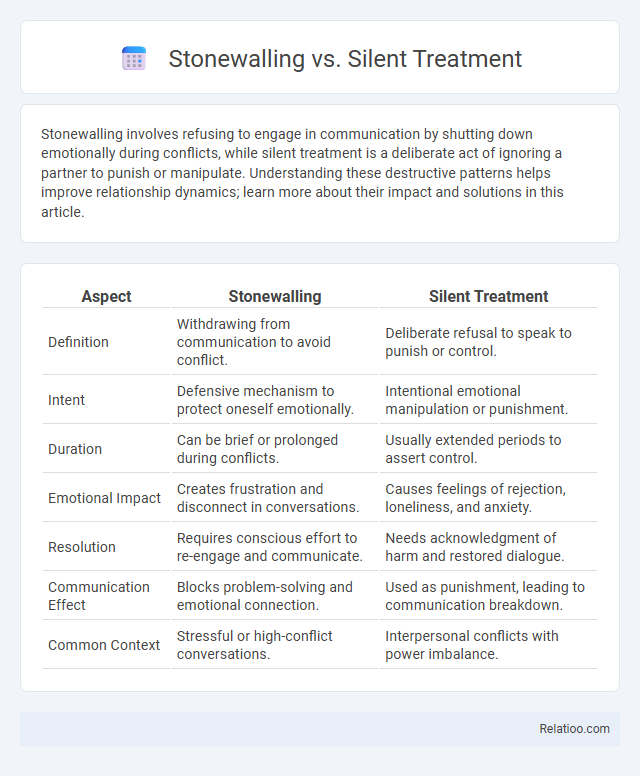Stonewalling involves refusing to engage in communication by shutting down emotionally during conflicts, while silent treatment is a deliberate act of ignoring a partner to punish or manipulate. Understanding these destructive patterns helps improve relationship dynamics; learn more about their impact and solutions in this article.
Table of Comparison
| Aspect | Stonewalling | Silent Treatment |
|---|---|---|
| Definition | Withdrawing from communication to avoid conflict. | Deliberate refusal to speak to punish or control. |
| Intent | Defensive mechanism to protect oneself emotionally. | Intentional emotional manipulation or punishment. |
| Duration | Can be brief or prolonged during conflicts. | Usually extended periods to assert control. |
| Emotional Impact | Creates frustration and disconnect in conversations. | Causes feelings of rejection, loneliness, and anxiety. |
| Resolution | Requires conscious effort to re-engage and communicate. | Needs acknowledgment of harm and restored dialogue. |
| Communication Effect | Blocks problem-solving and emotional connection. | Used as punishment, leading to communication breakdown. |
| Common Context | Stressful or high-conflict conversations. | Interpersonal conflicts with power imbalance. |
Understanding Stonewalling and Silent Treatment
Stonewalling and the silent treatment are both forms of communication withdrawal but differ significantly in intent and impact. Stonewalling involves emotionally shutting down to avoid conflict or overwhelm, often leaving conversations unresolved and increasing relational tension. Understanding these behaviors helps you recognize underlying emotional distress and fosters healthier communication strategies for conflict resolution.
Key Differences Between Stonewalling and Silent Treatment
Stonewalling involves completely withdrawing from communication, often as a defense mechanism, leading to emotional shutdown, while silent treatment is a deliberate, passive-aggressive refusal to engage aimed at punishing or controlling the other person. Stonewalling reflects an internal coping strategy, whereas silent treatment is an external behavior intended to manipulate. Understanding these distinctions helps you identify unhealthy communication patterns and address relationship conflicts more effectively.
Psychological Impact on Relationships
Stonewalling, characterized by emotional withdrawal and refusal to communicate, often leads to increased frustration and feelings of rejection in relationships. The silent treatment, a deliberate withholding of communication as a punitive measure, can cause significant emotional distress and erode trust between partners. Both behaviors contribute to emotional distance and impaired conflict resolution, exacerbating relational dissatisfaction and psychological stress.
Common Causes and Triggers
Common causes of stonewalling include emotional overwhelm, fear of conflict, and a desire to avoid confrontation, while the silent treatment often arises from feelings of anger, punishment motives, or attempts to exert control in a relationship. Triggers for stonewalling typically involve high stress or perceived threats to self-esteem, whereas the silent treatment can be provoked by misunderstandings or perceived slights. Recognizing these behaviors and understanding their triggers helps you address communication breakdowns and foster healthier interactions.
Recognizing the Warning Signs
Recognizing the warning signs of stonewalling involves identifying emotional withdrawal, avoiding eye contact, and refusing to engage in conversation, which often signals a breakdown in communication. Silent treatment is characterized by purposeful refusal to speak or acknowledge the other person, creating emotional distance and increasing tension. Distinguishing between stonewalling as a defensive coping mechanism and silent treatment as a deliberate punishment helps address underlying relationship issues effectively.
Effects on Communication and Conflict Resolution
Stonewalling creates a barrier in communication by refusing to engage, which intensifies frustration and hinders conflict resolution. The silent treatment, a deliberate refusal to speak, damages trust and emotional connection, leading to unresolved issues and increased resentment. You can improve communication and conflict resolution by recognizing these behaviors early and fostering open, empathetic dialogue.
Emotional Consequences for Both Parties
Stonewalling causes emotional distress by creating feelings of abandonment, frustration, and helplessness for the person being ignored, while the waller often experiences heightened anxiety and avoidance. Silent treatment prolongs emotional pain by fostering resentment and confusion, damaging trust and communication in the relationship. Repeated stonewalling reinforces negative emotional cycles, increasing emotional distance and reducing opportunities for resolution and emotional healing for both parties.
Healthy Alternatives to Stonewalling and Silent Treatment
Stonewalling and the silent treatment are communication barriers characterized by emotional withdrawal and refusal to engage, often escalating conflicts in relationships. Healthy alternatives include practicing open dialogue, using "I" statements to express feelings without blame, and setting clear boundaries to promote mutual understanding. Regular emotional check-ins and seeking couples therapy can also foster resolution and prevent resentment buildup.
Strategies for Breaking the Cycle
Breaking the cycle of stonewalling and silent treatment requires establishing open communication channels and fostering emotional safety within relationships. Techniques such as setting clear boundaries, engaging in active listening, and practicing timed breaks during conflicts help prevent escalation and encourage constructive dialogue. Consistent use of these strategies promotes mutual understanding and reduces emotional withdrawal.
When to Seek Professional Help
Persistent stonewalling, characterized by emotional withdrawal and refusal to communicate, often signals deeper relational issues that require professional intervention to prevent long-term damage. Silent treatment, involving intentional avoidance and punishment through silence, can escalate conflicts and emotional distress, necessitating counseling to rebuild healthy communication patterns. Recognizing when these behaviors become habitual or harmful is crucial, as therapy offers strategies to address underlying causes and foster constructive dialogue.

Infographic: Stonewalling vs Silent Treatment
 relatioo.com
relatioo.com